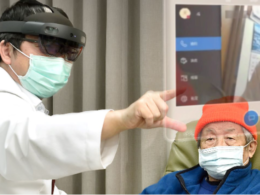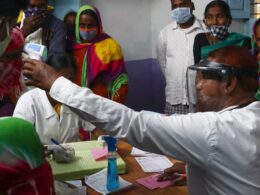the health strategist
research and strategy institute
for continuous health transformation
and digital health
Joaquim Cardoso MSc
Chief Researcher & Editor of the Site
April 11, 2023
ONE PAGE SUMMARY
A new report from the American College of Physicians (ACP) provides recommendations for telehealth quality performance measures in ambulatory care environments.
- The ACP, the largest medical specialty organization in the US with over 160,000 members in 145 countries, aims to ensure that telehealth performance measures are evidence-based, methodologically sound, and clinically meaningful.
- The report includes recommendations such as incorporating telehealth visits into measure attribution logic, ensuring telehealth performance measures do not adversely impact under-resourced communities, and testing appropriate measures for evaluating quality of care through telehealth.
- As telehealth continues to claim its place in healthcare delivery, stakeholders continue to provide recommendations to ensure its safety and efficacy.
The six recommendations are as follows:
1.Performance measures used to evaluate quality of care provided by a physician at a telemedicine visit should adhere to the same principles and criteria as for an in-person ambulatory care visit.
2.Performance measures should be evaluated to determine whether care delivered in a telemedicine setting should be included in the specifications, with careful consideration of how this might impact measure actionability or lead to unintended consequences.
3.Mechanisms should be put in place so that physicians, and their information systems, can have access to information generated at a telemedicine visit before a performance measure is used to evaluate quality of care.
4.There should be a focus on measures that promote patient safety, behavioral health, and care coordination.
5.Measures should be designed to be feasible, appropriate, clinically relevant, and patient-centered.
6.Future research should focus on identifying and addressing disparities in access to telemedicine, as well as understanding the impact of telemedicine on health outcomes and costs.
Source:
Health Care IT News
By Mark Melchionna
April 19, 2023
ORIGINAL PUBLICATION

Performance Measures for Physicians Providing Clinical Care Using Telemedicine: A Position Paper From the American College of Physicians
Annals of Internal Medicine
Amir Qaseem, MD, PhD, MHA, Catherine H. MacLean, MD, PhD, Samantha Tierney, MPH, J. Thomas Cross Jr., MD, Scott T. MacDonald, MD, Caroline L. Goldzweig, MD, and Nick Fitterman, MD, for the
Abstract
There has been an exponential growth in the use of telemedicine services to provide clinical care, accelerated by the COVID-19 pandemic. Clinical care delivered via telemedicine has become a major and accepted method of health care delivery for many patients. There is an urgent need to understand quality of care in the telemedicine environment. This American College of Physicians position paper presents 6 recommendations to ensure the appropriate use of performance measures to evaluate quality of clinical care provided in the telemedicine environment.
Measuring the quality of health care in the United States remains a challenge and has become even more complex with increased utilization of telemedicine. Telemedicine refers specifically to clinical services provided on a virtual platform, whereas telehealth includes a much broader scope of remote health care services, including nonclinical services.
Telemedicine visits have been steadily increasing. A Centers for Disease Control and Prevention (CDC) analysis found that during the first quarter of 2020, the number of telemedicine visits increased by 154%, compared with the same period in 2019 (1). Public and private payers continue to allow flexibilities during the pandemic to support this growth through temporary pay parity for telemedicine services and the relaxing of interstate licensing regulations (2). Telemedicine is expected to represent a large proportion of patient encounters (3) although there has been a recent downward trend in the use of these services (4, 5). Telemedicine is appealing to many patients primarily due to convenience and the safety of being seen at home (6). Telemedicine visits generally focus on several diagnoses ranging from mental health conditions to acute respiratory diseases and infections (4). Compared with in-person visits, telemedicine visits are usually shorter and include fewer diagnostic services (7).
The increase in use of telemedicine leads to questions about how care delivered via telemedicine could impact clinical outcomes, and how quality should be measured for telemedicine visits. Quality of care and clinical outcomes should not vary based on the clinical setting where care is provided.
The Performance Measurement Committee of the American College of Physicians (ACP) presents 6 recommendations for measuring quality of care provided under a telemedicine environment. The focus of this paper is telemedicine services, including via interactive audio and video telecommunications systems, provided in an ambulatory care environment. These recommendations are related to both health care systems in which telemedicine visits augment or are complementary to in-person visits, as well as “virtual-first” primary care in which patients receive all of their primary care needs virtually.

Methods
This policy paper was drafted by the ACP Performance Measurement Committee. Selected studies and reports related to telemedicine trends, adoption, and patient and physician satisfaction from PubMed and Google Scholar were reviewed. The review also included relevant news articles, policy documents, and websites. To ensure the currency of information and reflect recent data from the pandemic, any studies, reports and other sources older than 5 years were excluded. The Performance Measurement Committee posts its papers for review and comment by the ACP Board of Governors. In addition, the ACP Board of Regents also reviews, provides comments, and offers final approval of committee papers as ACP policy.

Recommendations
Recommendation 1: ACP recommends that performance measures used to evaluate quality of care provided by a physician at a telemedicine visit should adhere to the same principles and criteria as for an in-person ambulatory care visit.
Performance measures are used by various stakeholders to assess and monitor quality of care. They may be used to identify opportunities for quality improvement, accountability, and reporting, and as a factor to determine reimbursement. To close existing gaps in care, there is an interest in measures that are broad-based, meaningful, and patient-centered. Performance measures represent opportunities to improve the quality of patient care by assessing the structures, clinical processes, and clinical and patient-reported outcomes associated with high-quality health care. Recognition of persistent gaps between the care that is delivered, and the care supported by evidence-based clinical recommendations, continues to stimulate interest in the development of robust, evidence-based measures of quality of care (8). Telemedicine care is one component of care delivery. The overarching goals are unchanged when quality of care is being measured in a telemedicine setting.
For example, an existing measure looks to determine whether a patient with diabetes has a hemoglobin A1c level that is poorly controlled. A hemoglobin A1c greater than 9% is not acceptable regardless of the care setting, in-person or telemedicine. The measure remains a good indicator of quality.
With its Meaningful Measures 2.0 initiative, the Centers for Medicare & Medicaid Services (CMS) has identified high-priority areas for performance measures. These include measures that promote patient safety, behavioral health, and care coordination (9). ACP has described stringent criteria that can be used to assess performance measures (10), specifically importance, appropriateness, clinical evidence base, measure specifications, measure feasibility, and applicability. These domains are also relevant to measures that assess care delivered entirely or partially in a telemedicine setting.
Recommendation 2: ACP recommends that performance measures be evaluated to determine whether care delivered in a telemedicine setting should be included in the specifications, with careful consideration of how this might impact measure actionability or lead to unintended consequences.
Each existing measure should be evaluated to determine whether it is also appropriate for a telemedicine setting and how to operationalize it. Adjustments may need to be made and these changes will be incorporated behind the scenes or in the specifications of the measure. CMS defines specifications as “instructions for how to build and calculate a measure,” which describe at a minimum the numerator, denominator, and measure logic (11). Many programs incorporate process and outcome measures that have been adapted for the telemedicine setting. The Merit-Based Incentive Payment System (MIPS) includes 39 electronic clinical quality measures that can be used in a telemedicine setting for the 2022 performance period (12). In addition, the National Committee for Quality Assurance (NCQA) has updated 40 health plan measures to account for the increased use of telemedicine services (13).
We are unaware of any currently endorsed structural measures for telemedicine. However, there is a MIPS Improvement Activity (that is, use of telemedicine services that expand practice) that could be expanded on and potentially used as the basis of a future performance measure (14).
Questions need to be asked to determine whether a modification should be made to the measure specifications.
For the numerator, “Can completion of a process or outcome be measured through a telemedicine visit?” If so, the measure would need to clarify what would qualify as numerator compliance.
For example, NCQA’s “Controlling High Blood Pressure” measure has made the following numerator changes:
“Patient-reported readings taken with a digital device are acceptable and should be documented in the medical record along with the date.
Providers don’t need to see the reading on the digital device; the patient can verbally report it.”
For the denominator, “Can telemedicine visits be used to identify patients who should be included in the performance measure?”
For example, NCQA’s “HbA1c Poor Control” measure has been updated to include patient encounters conducted via telemedicine (for example, encounters coded with GQ, GT, 95, or POS 02 modifiers).
Recommendation 3: ACP recommends that mechanisms be put in place so that physicians, and their information systems, can have access to information generated at a telemedicine visit before a performance measure is used to evaluate quality of care.
Fragmentation in the U.S. health care system is well documented (15). Before the pandemic and the increase in telemedicine visits, U.S. physicians report that they did not routinely receive the information needed for managing a patient’s ongoing care. Information is not exchanged electronically outside of the practice (16). Recent data from the National Electronic Health Record Survey reports that 65% of physicians are able to electronically send, receive, or query for information from outside sources. However, only 29% can integrate information into the electronic health record (17). In addition, many studies and surveys demonstrate that clinical documentation requirements and electronic health record — related tasks represent the greatest source of burden for practicing physicians (18, 19).
The increase in the use of standalone telemedicine visits has the unintended consequence of further fragmenting care delivery and adding to the administrative burden of a physician’s already demanding schedule, particularly those visits originating outside of their practice or organization. Although some telemedicine companies are identifying ways of incorporating all patient data in one place, more can be done to enhance data continuity (20). According to a survey of hospital and physician practice managers, one third of telemedicine platforms are not integrated with electronic health records at all and only 17% were fully integrated (21). As a result, performance measures that are designed to assess the quality of one physician may have incomplete data that do not represent the full picture of care a patient has received (20). For instance, if a patient with major depressive disorder sees a primary care physician for initial care but then achieves remission under the care of another physician seen via telemedicine, the primary care physician would fail to meet the measure. Although this scenario can apply to many performance measures, it may be further exacerbated in the telemedicine setting where various telemedicine platforms are used. Federal interoperability mandates to share clinical data in machine-readable formats should improve this issue over time.
Recommendation 4: ACP recommends that performance measure testing must be conducted for a measure deemed appropriate to evaluate quality of care provided by a physician at a telemedicine visit.
The contribution of information obtained at a telemedicine visit should be considered in the context of all visits. Performance measure specifications and testing should be proven for a telemedicine environment and not automatically adapted from outpatient measures evaluating in-person visits.
Guidance from CMS acknowledges that a measure developed for one unit of analysis (such as payer, medical group, or individual) may not be valid for other units of analysis (11). As a result, CMS recommends that measures be respecified and retested for reliability and validity for all levels of analysis. The National Quality Forum (NQF) requires that testing be conducted for the measure as specified including all relevant levels of analysis and settings of care (22). Consistent with guidance from these national organizations, ACP will not support a measure that has not been tested at either the individual physician level or the group practice level, nor for different care settings for which the measure was originally specified. This is particularly important given the high-stakes nature of performance measures and given that measures are used for accountability, pay-for-performance programs, and public reporting.
The measures that have been changed to include telemedicine visits in the MIPS program and NCQA programs have not been tested and need to show that they are reliable and valid for a telemedicine environment, including the diabetes control measures. These measures must be validated before they can be used to assess physician performance in this care setting.
Recommendation 5: ACP recommends that telemedicine visits be incorporated into measure attribution logic (for example, individual physician, group practice level, and health plan).
Determination of whether quality measures should be attributed to a specific physician, health system, or health plan is complex in the poorly integrated U.S. health care system. Telemedicine visits add to this complexity. The structure, process, or outcome of interest in the measures should be under the control of the attributed unit of analysis if the measure is to be attributed to that unit. Similarly, the unit of analysis should have access to information on whether the measure structures, processes, or outcomes have been completed.
There are more than 150 attribution models (23) with substantial variability across models. Elements in these models may differ by timeframe, use of an episode of care as opposed to acute or chronic care, and use of majority or plurality of visits. How telemedicine fits into these models is as of yet undefined.
Attribution may be less of a concern for physicians and group practices who have adopted the patient panel model, in which a panel of patients is assigned to 1 physician or group practice. In this model, all patient visits should be evaluated, including telemedicine visits. However, attribution is unclear when a patient receives in-person and telemedicine care from different physicians. For many measures, numerator compliance relies on the most recent assessment of the process or outcome. Therefore, a physician who had his or her diabetic patient’s hemoglobin A1c under control may not be numerator compliant if the most recent value for a telemedicine visit is not controlled. There are some models that include patients receiving all of their primary care needs virtually, as well as a hybrid approach, where a patient supplements his or her in-person primary care visits with virtual visits from another physician for nonemergent medical needs.
Recommendation 6: ACP recommends that performance measures used to evaluate quality of care provided by a physician at a telemedicine visit should not marginalize underresourced communities already affected by the “digital divide” (24).
Telemedicine visits have the potential to increase access for patients in underserved, rural communities and for the elderly who have difficulty physically getting to sites of service. In fact, telemedicine visits have been found to decrease costs and travel time, and increase the ability to receive care that is needed (25). At the same time, there is growing evidence that the use of telemedicine can unduly impact disadvantaged communities (26). Underresourced communities likely do not have equal access to capable devices or high-speed internet service adequate for telemedicine. A substantial share of U.S. households face the possibility of not benefiting from telemedicine services. Rural households, households earning under $100 000 annually, and households without high-speed internet report lower telemedicine use (27). It is unclear whether incorporating telemedicine visits into the specifications of a quality measure will enhance quality and expand knowledge about performance among disadvantaged populations by increasing access or will confer an advantage to physicians with patients who have ready access to telemedicine visits. With diabetes, telemedicine has been shown to close gaps in diabetes management between Whites and Blacks (28). However, disparities still remain. As such, the effect of telemedicine on access and measured care quality of disadvantaged populations should be monitored carefully.
As with all quality measures, data on racial and ethnic disparities as well as social determinants of health should be collected and evaluated to determine the performance on measures that include telemedicine. In addition, analysis of outcomes by ZIP code or census tract and associated measures of social risk, such as the Area Deprivation Index, would identify local differences, particularly within the same city, and highlight opportunities for improvement.

Conclusion
Quality standards are fledgling in the telemedicine environment.
The same general principles for quality measurement that are applied to in-person care should apply to telemedicine care to ensure that patients receive consistent quality care with no effect on clinical outcomes.
Performance measures should be evaluated and modifications made to include telemedicine care.
Any performance measure should be tested for its reliability, validity, and attribution in a telemedicine environment.
One of the major limitations in health care continues to be availability and accessibility of data and this especially needs to be addressed for a telemedicine visit.
We need to be certain that any performance measure does not lead to unintended consequences including, most notably, negative consequences for underresourced communities.
Originally published at https://www.acpjournals.org












